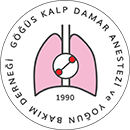

Cilt: 22 Sayı: 1 - 2016
| DERLEME | |
| 1. | Geriatrik hastalarda preoperatif dönemde istenilen konsültasyonların değerlendirilmesi, yorumlanması, kılavuz önerileri ve risk skorlaması The evaluation of preoperative consultations, guidelines and risc scoring systems in geriatric patients Elvin Kesimci, Fevzi Toramandoi: 10.5222/GKDAD.2016.001 Sayfalar 1 - 8 (2025 kere görüntülendi) Geriatrik nüfusun giderek artmasına bağlı olarak cerrahi tedavi alan geriatrik hastaların oranı da belirgin şekilde artmaktadır. Bu hastalarda anestezi uygulamaları; yaşlanmaya bağlı ortaya çıkan fizyolojik ve psikolojik değişimleri içine alacak şekilde spesifik bir yaklaşımla preoperatif dönemin daha iyi anlaşılmasını ve postoperatif dönemin daha sorunsuz geçirilmesini sağlamalıdır. Bu derlemede geriatrik hastalarda preoperatif dönemde istenilen konsültasyonların değerlendirilmesi, yorumlanması, kılavuz önerileri ve risk skorlamaları değerlendirilmiştir. |
| DENEYSEL ÇALIŞMA | |
| 2. | Kardiyopulmoner baypasta serum elektrolit ve ph değişimleri: stewart yöntemi ile analiz Serum electrolyte and ph alteratıons durıng cardıopulmonary bypass: analysis by the stewart approach Alper Kararmaz, Beliz Bilgili, Seçil Ayhan Özcan, Ömer Ayanoğlu, Zuhal Aykaçdoi: 10.5222/GKDAD.2016.009 Sayfalar 9 - 15 (1685 kere görüntülendi) GİRİŞ ve AMAÇ: Minimal vücut dışı dolaşım sistemi (MVDD) rezervuar içermemesi, devrelerinin heparin kaplı olması, santrifugal pompa kullanması gibi özellikleri ile konvansiyonel vücut dışı dolaşım sistemlerinden (KVDD) ayrılır. Çalışmamızda MVDD ve KVDD kullanılan elektif koroner arter cerrahisi geçiren olgularda kardiyopulmoner baypas (KPB) sırasında oluşan kan gazı değişikliklerinin fizikokimyasal yaklaşımla değerlendirilmesi amaçlandı. YÖNTEM ve GEREÇLER: KVDD ya da MVDD kullanılarak koroner arter cerrahisi uygulanan 59 olgunun verileri retrospektif olarak tarandı. MVDD kurulurken devreler izotonik NaCl ve hidroksietil nişasta solüsyonu ile dolduruldu, kanülasyondan sonra bütün olgularda otolog prime yapılarak bu solüsyon devre dışına alındı. KVDD hazırlanırken standart içerik ile devreler dolduruldu. KPB öncesi, KPB sırasında ve sonrasında alınan kan gazı verileri değerlendirildi. pH, pCO2, laktat, baz farkı (BE), hemoglobin ve kuvvetli iyon farkı (SID) değerleri kaydedildi. KPB ve kros klemp süreleri de kaydedildi. BULGULAR: MVDD grubu (n=29) ile karşılaştırıldığında, KVDD grubunda (n=30) KPB sırasında ve sonrasında hemoglobin değerleri daha düşük (p<0.001), KPB sırasında SID, BE ve pH daha yüksek bulundu (p<0.0001). KVDD grubunda SID ve pH yüksekliğinin nedeni KPB başlangıç solüsyonunun yüksek sodyum içeriğiydi. MVDD grubunda KPB sırasında SID ve pH değişmez iken KPB sonrasında klor artışına bağlı olarak SID azaldı fakat pH etkilenmedi. KVDD grubunda laktat değerleri MVDD grubundan daha yüksekti (p<0.01). KPB ve kros klemp süreleri KVDD grubunda daha uzundu (p<0.01). TARTIŞMA ve SONUÇ: Vücut dışı dolaşım için MVDD kullanıldığında konvansiyonel pompaya göre hemoglobinin ve pHnın daha stabil seyredebileceğini gösterilmiştir. Kullandığımız yüksek SID içerikli başlangıç solüsyonun ve hemodilüsyonun KVDD grubunda metabolik alkaloza neden olduğunu fizikokimyasal analiz ile saptadık. |
| 3. | Koroner Arter Baypas Greftleme Cerrahisi Sonrası Erken Dönemde Gelişen Komplikasyonlar ve İlişkili Etiyolojik Faktörler Etiological Factors Concerning The Early Complications That Occur Following Coronary Artery Bypass Graft Surgery İpek Mavili, Cengiz Şahutoğlu, Zeynep Pestilci, Seden Kocabaş, Fatma Zekiye Aşkardoi: 10.5222/GKDAD.2016.016 Sayfalar 16 - 23 (2126 kere görüntülendi) GİRİŞ ve AMAÇ: Anestezi ve cerrahideki gelişmelere bağlı olarak koroner arter baypas greftleme (KABG) ameliyatlarının giderek yaygınlaşması ve değişen hasta profili peroperatif dönemde daha fazla komplikasyonla karşılaşılmasına neden olmaktadır. Bu komplikasyonlara bağlı olarak mortalite ve morbidite oranları artmakta, hastanede ve yoğun bakımda kalış süresi uzamaktadır. Çalışmamızda KABG cerrahisinde komplikasyon gelişimine neden olan etiyolojik faktörlerin saptanması hedeflenmiştir. YÖNTEM ve GEREÇLER: Ocak 2011 Aralık 2012 tarihleri arasında opere olmuş 400 hastanın dosyası retrospektif olarak incelendi. Hastaların yaş, cinsiyet, kilo, boy, vücut kitle indeksi (BMI), ejeksiyon fraksiyonu, EuroSCORE (European system for cardiac operative risk evaluation skoru), ek hastalık varlığı, yapılan anastamozların sayısı, aorta kros klemp ve KPB süreleri, postoperatif inotrop desteği, mekanik ventilatörde kalış süresi, yoğun bakımda ve hastanede kalış süresi, gelişen komplikasyonlar not edildi. Ortaya çıkan komplikasyonlarla bu değişkenler arasındaki ilişki istatiksel olarak araştırıldı. BULGULAR: Hastaların ortalama yaşları 61,4± 9,4 yıl ve 307si erkek idi. Hastalarda %29,8 oranıyla en sık kardiyak komplikasyon görüldü. Bunu renal disfonksiyon (%21) ve solunumsal komplikasyonlar (%12,3) izledi. Hastaların %41,5inde bir komplikasyon, %19unda ise iki ve üzerinde komplikasyon gelişti. Çok yönlü lojistik regresyon analizinde erkek cinsiyet, yüksek BMI, yüksek EuroSCORE, inotropik ajan kullanımı, uzun KPB süresi ve yapılan koroner anastomoz sayısı komplikasyonlar için bağımsız risk faktörü idi. Komplikasyon gelişen hastaların ekstübasyon, mekanik ventilasyon,yoğun bakım ve hastane yatış süreleri anlamlı olarak uzamış bulundu (p = 0,05). TARTIŞMA ve SONUÇ: Preoperatif dönemde hastaların operasyona ayrıntılı hazırlanması ve optimal sağaltımın yapılması, miyokard koruma tekniklerine uyulması ve operasyon sürelerinin azaltılması ile komplikasyon oranlarında azalma sağlanabilecektir. |
| 4. | Postanestezi Bakım Ünitesinde Görülen Postoperatif Rezidüel Kürarizasyon: Klinik Testlerle İlişkisi Postoperative Residual Curarization in Postanesthesia Care Unit: Relationship With Clinical Tests Gonca Oğuz, Süheyla Ünver, Gülşah Açıkgöz, Oruç Emre Solmaz, Yeliz İrem Tunçeldoi: 10.5222/GKDAD.2016.028 Sayfalar 24 - 28 (1293 kere görüntülendi) GİRİŞ ve AMAÇ: Nöromusküler blokörlerin rezidüel etkileri erken postoperatif döneme uzayabilir. Nöromusküler bloğun derecesini değerlendirmede train-of-four stimülasyonu kullanılmakla beraber birçok anestezist hala klinik testleri tercih etmektedir. Yeterli solunum fonksiyonu için train-of-four oranının eşik değeri 0.9 olarak kabul edilmektedir. Bu çalışmada, postanestezi bakım ünitesinde görülen postoperatif rezidüel kürarizasyon insidansı ve train-of-four oranlarının klinik testlerle ilişkisi araştırıldı. YÖNTEM ve GEREÇLER: Çalışmaya genel anestezi altında cerrahi girişim uygulanan 128 hasta dahil edildi. Rezidüel kürarizasyon postanestezi bakım ünitesinde train-of-four stimülasyon ile ölçüldü. Aynı zamanda, 5 saniye başını kaldırabilme, göz açma, el sıkma ve dil çıkarma becerileri de değerlendirildi. Ek neostigmin ihtiyacı, solunum için sözel veya mekanik stimülasyon ve reentübasyon kaydedildi. BULGULAR: Hastaların % 18'inin train-of-four oranı ≤0.7, % 32.8'i 0.7-0.9 ve %49.2'si ≥0.9'du. Train-of-four oranları baş kaldırma ve el sıkmayla zayıf-orta derecede pozitif korelasyon gösterdi. Korelasyon katsayısı en fazla baş kaldırmayla anlamlıydı (0.318, p=0.000). Amerikan Anestezistler Derneği sınıflandırması ile korelasyon negatif olarak bulundu (-0.289, p=0.001). Train-of-four oranı ≤0.7 olan 23 hastanın 11'i 5 saniye baş kaldırabilirken, train-of-four ≥0.9 olduğunda bu sayı 63 hastada 56'ya yükseldi. TARTIŞMA ve SONUÇ: Postoperatif bakım ünitelerinde nöromusküler blokörlerden yetersiz derlenme önemli bir problemdir. Klinik testler postoperatif rezidüel parezi ile iyi korelasyon göstermemektedir. Hasta sonuçlarını iyileştirmek için objektif nöromusküler monitörizasyon ve optimal antagonizma uygulanmalıdır. |
| 5. | Travma hastalarında skorlama sistemlerinin yoğun bakım mortalitesi açısından değerlendirilmesi Evaluation of the scoring systems in trauma patients to predict intensive care mortality Fatma Yıldırım, İskender Kara, Hamit Küçük, Lale Karabıyık, İsmail Katıdoi: 10.5222/GKDAD.2016.029 Sayfalar 29 - 33 (2330 kere görüntülendi) GİRİŞ ve AMAÇ: Bu çalışmada, travmalı yoğun bakım hastalarında, Akut Fizyoloji ve Kronik Sağlık Değerlendirmesi (APACHE II), Ardışık Organ Yetmezliği Değerlendirme Skoru (SOFA), Glasgow Koma Skoru (GKS) ve Revize Travma Skorunun (RTS) prognozu öngörmeye katkısının retrospektif olarak karşılaştırılması amaçlandı. YÖNTEM ve GEREÇLER: Anesteziyoloji yoğun bakım ünitesinde Ocak 2013-Ekim 2013 arasında tedavi görmüş travma hastalarının demografik verileri, travma etiyolojileri, kabul yerleri, yatış süreleri, mortaliteleri ve APACHE II, SOFA, GKS, ve RTS skorları kaydedildi. Skorlar ile yoğun bakım mortalitesi arasındaki ilişki incelendi. BULGULAR: Çalışmaya alınan 31 hastanın (20 Erkek, 11 Kadın) median yaşı 43 [25-61] idi, 19 (61.3)u exitus, 12 (38.7)si taburcu edilmişti. Exitus olan ve taburcu edilen gruplar arasında yaş, cinsiyet, travma etiyolojileri, kabul yerleri, yatış süreleri açısından fark tespit edilmedi (p>0.05). Exitus grubundaki hastaların APACHE II skorları daha yüksekti (median 15 vs 9, p=0.035). Skorlama sistemlerinin mortaliteyi öngörmede değerini tespit etmek için yapılan ROC eğri analizine göre, eğri altındaki alan APACHE II için 0.726 (p=0.037), GKS için 0.393 (p=0.320), SOFA için 0.625 (p=0.248), RTS için 0.412 (p=0.417) olarak tespit edildi. Korelasyon katsayıları sırasıyla -0.630, 0.894, -0.545 ve 1.0 bulundu. TARTIŞMA ve SONUÇ: Travma hastalarında APACHE II skoru mortaliteyi öngörmede daha etkili gözükmektedir. |
| OLGU SUNUMU | |
| 6. | Stuck Kapak Nedeniyle Operasyona Alınan Gebede Anestezi Yönetimi Anesthetic management of a pregnant patient who underwent surgery due to stuck valve Hülya Kaşıkara, Aslıhan Küçüker, Melahat Yıldırım, Cemile Altın, Gökçer Uğur, Şemsi Mustafa Aksoy, Abdulkadir Butdoi: 10.5222/GKDAD.2016.034 Sayfalar 34 - 37 (2001 kere görüntülendi) Giriş: Mitral kapakta tromboz nedeniyle stuck kapak saptanan ve buna bağlı olarak akut kalp yetmezliği ve pulmoner ödem tablosunda acil operasyona aldığımız 28 haftalık gebenin anestezi yönetimi sunulmuştur. Olgu sunumu Nefes darlığı şikayeti ile başvuran 28 haftalık gebe, MVR( mitral valve replacement) stuck kapak saptanması üzerine acil operasyon için hastanemize sevkedilmiştir. Transtorasik ekokardiyografisinde EF %55, protez mitral kapak disfonksiyene, açılımı kısıtlı, sağ boşlukları ileri derecede dilate, pulmoner arter basıncı 65mmhg, 2-3.derece aort yetmezliği, 2.derece triküspit yetmezliği mevcut idi. Operasyon masasına alınan hastada, ekstremite uçlarında ve dudaklarda hafif siyanoz, takipne, ortopne ve hemoptizi mevcuttu. Batın ultrasonografide uterusta 28 haftalık canlı fetüs olduğu tespit edildi. Hastanın, isteği doğrultusunda trombolitik tedavi başlanmadı. Genel anestezi altında önce sezaryen ile bebek canlı olarak doğurtuldu ve ardından kardiyopulmoner baypass ile mitral kapak değişimi yapıldı. Sonuç: Nonfonksiyone mitral kapak nedeniyle operasyona aldığımız gebede uygun bir anestezi ve cerrahi planlama yapılarak anne ve bebekte komplikasyon yaşanmadan operasyon tamamlandı. |
| 7. | Açık Kalp Cerrahisi Uygulanan Pediatrik Hastada Preoperatif Otolog Donasyon: Olgu Sunumu Preoperative Autologous Donation In A Pediatric Patient Undergoing Open Heart Surgery: Case Report Cengiz Şahutoğlu, Nursen Karaca, Seden Kocabaş, Fatma Zekiye Aşkar, Alev Atalay, Yüksel Ataydoi: 10.5222/GKDAD.2016.038 Sayfalar 38 - 40 (1450 kere görüntülendi) Pediatrik açık kalp cerrahisi; kardiyopulmoner baypas esnasında kan kullanımının zorunlu ve kan transfüzyon oranlarının yüksek olduğu majör bir uygulamadır. Hastalar için çapraz karşılaştırmada uyumlu kan bulunamaması oldukça nadirdir ve elektif vakaların ertelenmesine neden olmaktadır. Bu hastalarda preoperatif otolog donasyon gibi kan koruma yöntemlerinin uygulanması gereklidir. Bu makalede, konjenital mitral yetmezlik nedeniyle opere edilen ve çapraz karşılaştırmada uyumlu kan bulunamaması nedeniyle preoperatif otolog donasyon uygulanan hastamızı sunmaktayız. |
| 8. | Akut Sıkıntılı Solunum Sendromunun nadir sebebi: Şilotoraks A rare cause of acute respiratory distress syndrome: Chylothorax Beliz Bilgili, Fethi Gül, İsmail Cineldoi: 10.5222/GKDAD.2016.041 Sayfalar 41 - 44 (1461 kere görüntülendi) Şilotoraks, ductus torasikusun travma veya altta yatan kansere bağlı olarak kesilmesi veya tıkanması sonucu meydana gelmektedir. Yüksek trigliserid ve düşük kolestrol ile karakterize plevral efüzyonun nadir sebebidir. Şilotoraks ilişkili akut sıkıntılı solunum sendromu (Acute Respiratory Distress Syndrome; ARDS) ender görülen bir durumdur. Olgu sunumunda, koruyucu mekanik ventilasyon stratejileri, uzun sureli pron pozisyon ve ductus torasikus ligasyonu ile tedavi edilen, yüksek akım şilotoraksa bağlı gelişen ARDS hastası aktarılmıştır. |

















